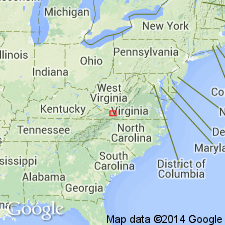
- Usage in publication:
-
- Price sandstone
- Modifications:
-
- Named
- Dominant lithology:
-
- Sandstone
- Shale
- Coal
- AAPG geologic province:
-
- Appalachian basin
Summary:
Price sandstone here named for Price Mountain in Montgomery Co., southwestern VA. Consists of alternating coarse yellow or green sandstones, beds of shale, and coal. Overlies Kimberling shale and underlies Pulaski shale [Maccrady formation]. [In later reports thickness given as 200 to 420 ft or more.] Age is Mississippian (Osagean).
Source: GNU records (USGS DDS-6; Reston GNULEX).
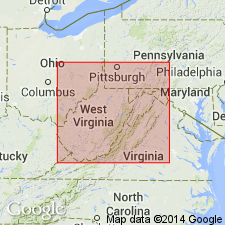
- Usage in publication:
-
- Price Formation
- Modifications:
-
- Revised
- AAPG geologic province:
-
- Appalachian basin
Summary:
Cussewago Member of Price Formation cannot be confidently identified in the study area. Rocks assigned to Cussewago by Kammer and Bjerstedt (1986) are more likely the basal part of the Riddlesburg Member, hence these authors recognize only the Oswayo, Riddlesburg, and Rockwell as Members. Price Formation unconformably underlies the Greenbrier Limestone and overlies the Hampshire Group (rank raised in this area). Age is Late Devonian to Early Mississippian.
Source: GNU records (USGS DDS-6; Reston GNULEX).
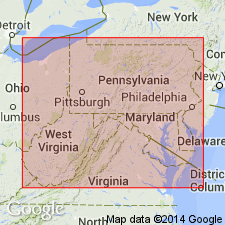
- Usage in publication:
-
- Price Formation
- Modifications:
-
- Biostratigraphic dating
- Overview
- Dominant lithology:
-
- Sandstone
- Siltstone
- Shale
- AAPG geologic province:
-
- Appalachian basin
Summary:
Age of the Price Formation in WV is documented by three brachiopod fauna. The oldest two are of very late Devonian (late Famennian) age and are found in outcrops north of the West Virginia dome, at Hendricks and Rowlesburg, WV, and Summit, PA. The youngest fauna described here is of very early Carboniferous (early Kinderhookian age) and is widespread to the south. Therefore, Price Formation considered time-transgressive from northern to southern WV. This concept supported by Kammer and Bjerstedt (1986) who reported Osagean fauna in extreme southern WV. This conflicts with Englund and others (1988: Abstract, AAPG Bull. v. 72, p. 961) who view the Price as time-transgressive from south to north.
Source: GNU records (USGS DDS-6; Reston GNULEX).
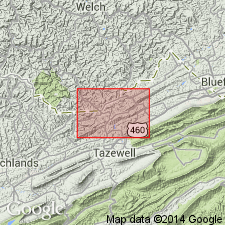
- Usage in publication:
-
- Price Formation*
- Modifications:
-
- Age modified
- AAPG geologic province:
-
- Appalachian basin
Summary:
Considered to be Early Mississippian in this area. [Per telecom with Englund, Boswell (1987) lowers the age to Late Devonian, but Englund does not agree with the revised age for this area.]
Source: GNU records (USGS DDS-6; Reston GNULEX).
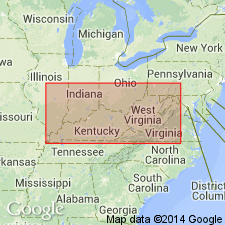
- Usage in publication:
-
- Price Formation
- Modifications:
-
- Overview
- AAPG geologic province:
-
- Appalachian basin
Summary:
Though geologists have long considered Lower Mississippian rocks on opposite sides of the Appalachian basin to be essentially age equivalent, the outcrops in WV contain beds older than those in KY, but compose a single progradational depositional sequence that is divided in this report into allo-units. The upper part of the Price Formation (mostly Kinderhookian) in Caldwell, WV, is almost completely older than the Borden Formation (mostly Osagean) in Morehead, KY. The Kinderhookian boundary lies within the Henley Bed near the base of the Borden. The overlying Farmers, Nancy, Cowbell, and Nada Members are Osagean. Contacts between members are gradational indicating a slowly changing depositional environment. The Kinderhookian boundary in WV lies near the top of the Price Formation and the overlying Maccrady Formation is entirely Osagean. The upper Price comprises allo-units A, B, C, and a small part of D, where the top of C is recognized as the Kinderhookian/early Osagean boundary based on conodonts and ammonoids.
Source: GNU records (USGS DDS-6; Reston GNULEX).
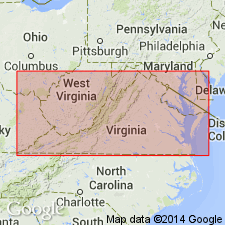
- Usage in publication:
-
- Price Formation
- Modifications:
-
- Overview
- AAPG geologic province:
-
- Appalachian basin
Summary:
Unit crops out from Cumberland Gap northeastward to Little Stone Gap, around the nose of Powell Valley anticline and then southward around the end of Powell Mountain. It is present in the subsurface throughout the southwest VA coalfield. Ranges in thickness from 150 to 320 ft. Consists of two units, a lower interbedded siltstone, shale, and sandstone and an upper sandstone. Age of the Price Formation given in this report as Early Mississippian (Osagean). Gradationally overlies the Kinderhookian Big Stone Gap Member of the Chattanooga Shale and gradationally underlies the Meramecian Maccrady Shale.
Source: GNU records (USGS DDS-6; Reston GNULEX).
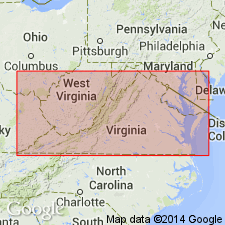
- Usage in publication:
-
- Price Formation
- Modifications:
-
- Overview
- AAPG geologic province:
-
- Appalachian basin
Summary:
Price Formation, approximate equivalent of the Pocono Formation of northern VA, tops the Mason Cove plane table section near the crest of Fort Lewis Mountain. The Cloyd Conglomerate Member occurs 15 m above the underlying Hampshire Formation. Although a second bed of Cloyd-like conglomerate about 200 m above the basal Cloyd was recognized by Kreisa and Bambach (1973), authors here restrict the usage to the 3-m-thick bed near the base of the Price, which conforms to its description at the type locality. Authors also accept the 152-m thickness for the Price reported by Amato (1974) rather than the 350-m thickness reported by Kreisa and Bambach. Base of the Sunbury Shale Member used to mark the Devonian-Mississippian boundary, in agreement with Bjerstedt and Kammer (1988). Therefore age of the Cloyd is considered latest Devonian and age of the Price, latest Devonian and Early Mississippian.
Source: GNU records (USGS DDS-6; Reston GNULEX).
For more information, please contact Nancy Stamm, Geologic Names Committee Secretary.
Asterisk (*) indicates published by U.S. Geological Survey authors.
"No current usage" (†) implies that a name has been abandoned or has fallen into disuse. Former usage and, if known, replacement name given in parentheses ( ).
Slash (/) indicates name conflicts with nomenclatural guidelines (CSN, 1933; ACSN, 1961, 1970; NACSN, 1983, 2005, 2021). May be explained within brackets ([ ]).

